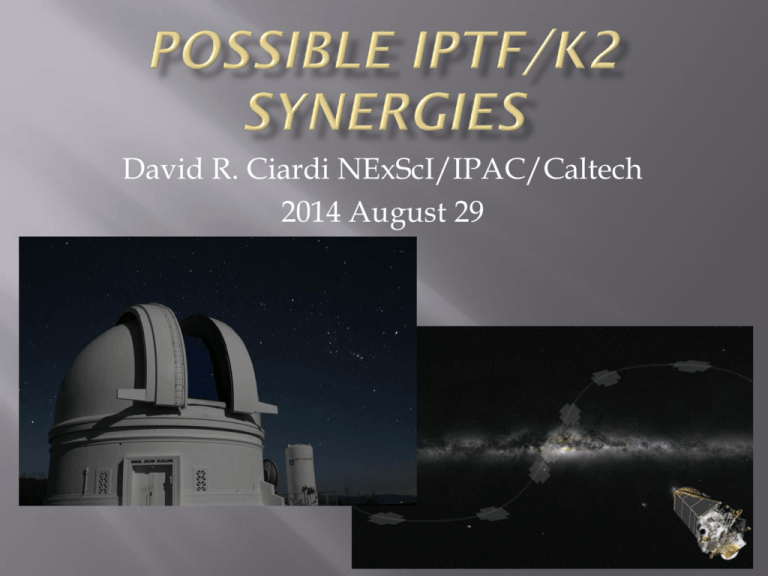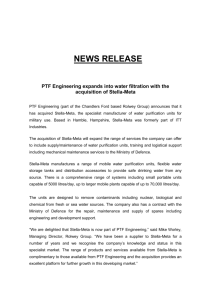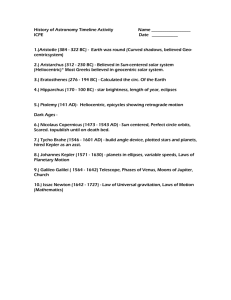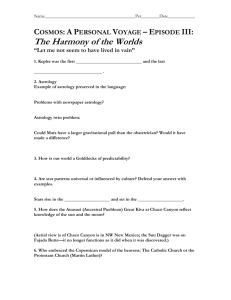Possible iPTF/K2 Synergies
advertisement

David R. Ciardi NExScI/IPAC/Caltech 2014 August 29 Kepler/K2 iPTF Telescope 1m Schmidt 1m Schmidt Field of View 10o x 10o (100 sq. degrees) 3.5o x 2.3o (7.26 sq. degrees) Postage stamps Full frames Pixel Scale 4”/pixel 1.01”/pixel Observing Cadence 30 minutes for most targets 1 minute for ~10% targets 60 seconds integration time but flexible. Sampling flexible but typical experiments have been 90 seconds to 5-days sampling Field Duration ~70 – 80 days Flexible but generally any one field is available for months depending on declination. Data availability Pixel data available a few months Data available in real time after end of campaign Orientation Aligned with ecliptic 8/28/2014 Aligned in equatorial coordinates 2 8/28/2014 18-20 iPTF Pointings 3 8/28/2014 4 8/28/2014 5 8/28/2014 6 Field Observed R.A. by Kepler Dec. PTF g PTF r Dates Observed by PTF Kepler 2009 - 2014 19:22:40.00 +44:30:00.0 119 50 3/16/11-9/27/12 K2 0 2014 Apr 30 06:33:11.14 +21:35:16.4 17 16 3/28/10-3/26/14 K2 1 2014 Jul 22 11:35:45.51 +01:25:02.3 0 22 5/24/13-3/8/14 K2 2 2014 Oct 14 16:24:30.34 -22:26:50.3 0 2 2/26/10-2/26/10 K2 3 2015 Jan 05 22:26:39.68 -11:05:48.0 0 21 6/26/09-8/28/10 K2 4 2015 Mar 29 03:56:18.22 +18:39:38.1 0 47 8/24/10-2/18/14 K2 5 2015 Jun 20 08:40:37.84 +16:49:46.6 0 69 1/18/09-5/19/14 K2 6 2015 Sep 11 14:01:11.20 -13:16:02.8 0 0 null K2 7 2015 Dec 03 19:34:16.22 -22:38:23.4 0 19 7/27/11-6/16/13 K2 8 2016 Feb 24 01:04:43.18 +05:11:52.2 0 38 7/8/10-11/2/12 K2 9 2016 May 17 18:23:35.72 -24:12:12.8 0 23 7/3/14-8/15/14 8/28/2014 7 Field Kepler K2 0 K2 1 K2 2 K2 3 K2 4 K2 5 K2 6 K2 7 K2 8 K2 9 Galactic Longitude Galactic Latitude 76 191 264 354 51 172 209 327 16 129 8 13 6 58 18 -52 -25 32 46 -20 -57 -5 Notes Original Kepler Field Low latitude, anti-center North Galactic Cap Near Galactic Center, rho Oph, U. Sco South Galactic Cap Pleiades, Hyades M44, M67 North Galactic Cap Near Galactic Center South Galactic Cap Galactic Center, Baades Window – mlens!! All fields at low ecliptic latitude (< 1 degree from ecliptic) – good for solar system! 8/28/2014 8 Campaigns start a maximum of 52 days before each date and end no later than 30 days after each date. 8/28/2014 9 Northern Fields easier to do Most southernly fields (declination ~ -25o) just barely get above airmass of 2 (Fields 2, 7, 9) Fields 3 and 6 climb above 2 airmass but not for long (declination ~ -12o) Amount of time fields are available for simultaneous observations depends upon field but is typically 10 - 30 days at the beginning of a campaign 8/28/2014 10 8/28/2014 Started 22 Aug Because of low declination, never gets above 2 airmass during the K2 observation window 11 8/28/2014 Starts early/midFebruary Because of higher declination available with PTF for first 30-40 days depending on exact field start with Kepler 12 Winter fields most accessible – but they precede the K2 observations. Otherwise, fields are available about 6 – 7 months after K2 campaign Good timing for enabling of followup 8/28/2014 13 Hard to do preparatory observations because of time cycle of proposals Targets for Fields 4 and 5 due now (late September) Fields 6 and 7 First observable Feb/Mar 2015 Proposals due end of Feb 2015 Fields 8 and 9 First Observable Field 8: Jun/Jul 2015 Field 9: Apr/May 2015 8/28/2014 Proposals due end of July 2015 But Field 9 is special 14 Points ahead of the Earth Field available from ground throughout the campaign mlens events observed from Earth and Kepler yields parallaxes 5 sq deg. dedicated to mlens; 15% to other GO targets 8/28/2014 15 Wide-field multi-band photometry High cadence time series photometry Seeing-limited resolution Pre or Post SED characterization Pre or Post or Simultaneous time series data complementary to K2 Photometric Deblending of K2 targets 8/28/2014 16 K2 observing about 10 clusters Need supporting observations to determine Need wide-field of view Deep observations to get to end of the main sequence Cluster membership (colormagnitude diagram) Deblending (higher resolution imaging) 8/28/2014 Pleiades Hyades M44 M67 … To Name a Few 17 K2 Fields are all in the ecliptic! NEOs and asteroids move too much between discovery, K2 proposal process, and start of K2 observations Slow moving objects discovered by PTF may stay in field long enough to be remain in K2 Field (e.g., Trojans, KBOs, trans-Neputunian objects) Colors and rotation periods 8/28/2014 18 Quicker time cadence than K2 Multiband, wide-field photometry: deeper and better resolution than K2 All K2 fields observable with PTF Only northern fields have realistic chance of simultaneous PTF/K2 observing Except for Field 9 which is the mlensing field PTF may be good for identification of variable objects worthy of K2 following – if PTF observes the field soon enough (older data?) PTF is probably better at following up K2 targets discovered to be interesting 8/28/2014 19











